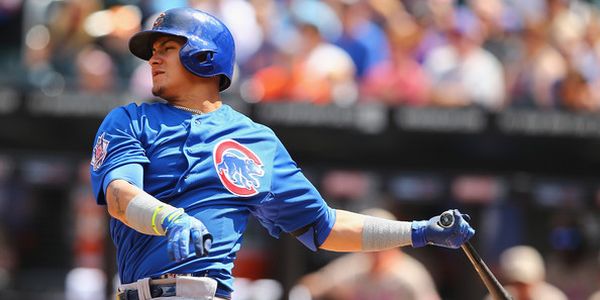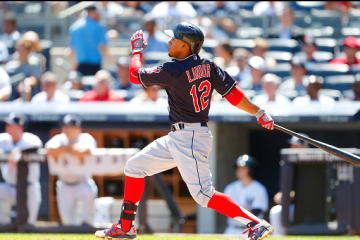NFBC ADP vs Steamer Projections – Middle Infielders

We’re rounding up our NFBC ADP vs Steamer projections analysis with middle infielders. Those of you who haven’t read the previous articles, the premise is that we’re looking at players who have very differing ADPs in live NFBC drafts but not significant differences in their Steamer projections, therefore finding potential value in your drafts.
| Name | NFBC ADP | Team | G | PA | AB | HR | R | RBI | SB | AVG | OBP | SLG |
| Javier Baez | 14 | Cubs | 147 | 632 | 586 | 29 | 81 | 96 | 17 | 0.269 | 0.313 | 0.488 |
| Rougned Odor | 130 | Rangers | 149 | 631 | 574 | 28 | 78 | 84 | 16 | 0.249 | 0.307 | 0.453 |
Starting off at the second base position and a reminder, the above are their Steamer projections heading into Spring. Comparing a guy who was second in the NL MVP voting last year to someone who was considered a bust from drafts last year may seem crazy. But just a glance at the Steamer projections tells a tale of two players with very similar expectations and very little difference in their potential outcomes, yet a wide disparity on their draft prices.
The extra 12 RBIs to Baez and a better batting average of .020 are the only standout differences. One home run, one stolen base and three runs are all negligible. For those in OBP leagues, the difference there is negligible. What isn’t negligible is the 116-position difference they are seeing in drafts. Baez has even been drafted as early as fifth and has the earliest ADP of all second base eligible players. Odor hasn’t been drafted earlier than 82nd overall and is 12th among his peers. But is there a valid reason for this?
Baez had his long-awaited breakout in 2018, almost doubling his previous two years’ homers and steals combined. Regarded as a free-swinger at the plate, rather than changing his approach to take more walks and show more patience, Baez went the other way and started swinging more. His BB% went down on 2017 but you can’t say it didn’t work. Is it sustainable? Probably not. The projected comeback seems fair.
Odor’s breakout came in 2016 with the subsequent years being a disappointment. 2017 saw the power remain to the tune of a .067 drop on his batting average. Last year saw the batting average climb back up but the power disappeared. A hamstring injury saw Odor miss a month, but his second half was excellent, almost to the point it may have cost those who dumped him off their teams earlier in the season a chance at winning their championship. That second half still sits in the mind and will get people back interested in him again. The one issue which I’d be most concerned about is his lowly 50% success rate in steals last year. That needs to improve to ensure he’s still given enough of a green light.
Baez’s ADP is mainly being driven by hopes of a repeat to his 2018. The projections suggest there won’t be, and he won’t be coming at a discount in your draft. So, going a different direction then nabbing Odor 9-10 rounds later seems like a solid plan to me.
Next up are two shortstops who have had surprisingly similar seasons in 2017 and 2018. My intention was looking at similar speedsters at the position, but Carlos Correa and Paul DeJong’s numbers are so near identical, it was somewhat startling.
| Name | NFBC ADP | Team | G | PA | AB | HR | R | RBI | SB | AVG | OBP | SLG |
| Carlos Correa | 50 | Astros | 135 | 585 | 509 | 23 | 78 | 83 | 4 | 0.265 | 0.352 | 0.466 |
| Paul DeJong | 187 | Cardinals | 131 | 550 | 500 | 23 | 65 | 76 | 2 | 0.254 | 0.311 | 0.449 |
Their combined 2017-18 numbers are as follows;
| Name | G | HR | R | RBI | SB | AVG |
| Carlos Correa | 219 | 39 | 142 | 149 | 5 | 0.278 |
| Paul DeJong | 223 | 44 | 123 | 133 | 2 | 0.263 |
The extra runs and RBIs plus better batting average gives Correa the edge. The Cardinals addition of Paul Goldschmidt does even things a little more, especially if DeJong can secure a spot in the top half of the lineup. It’s hard to call into question the Steamer projections when looking at the last two years. Correa could always get more active on the bases having topped double digits in steals in 2015 and 2016. That’s more of a hope than expectation at this point though with only five stolen bases in the last two years, so any noticeable edge Correa will have over DeJong is likely to come in the runs and RBI department.
Correa has a slightly stronger track record but has seen himself falling down the draft rankings each of the last two years. He was considered a strong second rounder last year. But to that point, shortstop is possibly the strongest position in terms of depth this year. On NFBC, the 12th ranked shortstop in ADP is being drafted inside the top 90 overall and a total of 20 shortstops have an ADP of 200 or earlier. That means waiting on shortstop for a few rounds isn’t going to do as much damage as waiting on first basemen for example. It’s also the position which offers the most variety in stats with speed and power mixed in throughout the top 20.
If you didn’t already know there were 133 places between their ADPs, would you have said there would be such a big difference between these two when looking at their projections or their last two years? I’d argue only a couple of rounds difference would be expected, meaning DeJong should offer much more value for money than Correa.





